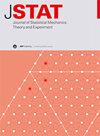Variability of entropy force and its coupling with electrostatic and steric hindrance interactions
IF 1.9
3区 物理与天体物理
Q2 MECHANICS
Journal of Statistical Mechanics: Theory and Experiment
Pub Date : 2024-04-17
DOI:10.1088/1742-5468/ad363e
引用次数: 0
Abstract
We investigated the effective interaction potential (EIP) between charged surfaces in solvent comprised of dipole dimer molecules added with a certain amount of ionic liquid. Using classical density functional theory, the EIP is calculated and decoupled into entropic and energy terms. Unlike the traditional Asakura–Oosawa (AO) depletion model, the present entropic term can be positive or negative, depending on the entropy change associated with solvent molecule migration from bulk into slit pore. This is determined by pore congestion and disruption of the bulk dipole network. The energy term is determined by the free energy associated with hard-core repulsion and electrostatic interactions between surface charges, ion charges, and polarized charges carried by the dipole dimer molecules. The calculations in this article clearly demonstrate the variability of the entropy term, which contrasts sharply with the traditional AO depletion model, and the corrective effects of electrostatic and spatial hindrance interactions on the total EIP; we revealed several non-monotonic behaviors of the EIP and its entropic and energy terms concerning solvent bulk concentration and solvent molecule dipole moment; additionally, we demonstrated the promoting effect of dipolar solvent on the emergence of like-charge attraction, even in 1:1 electrolyte solutions. The microscopic origin of the aforementioned phenomena was analyzed to be due to the non-monotonic change of dipolar solvent adsorption with dipole moment under conditions of low solution dielectric constant. The present findings offer novel approaches and molecular-level guidance for regulating the EIP. This insight has implications for understanding fundamental processes in various fields, including biomolecule-ligand binding, activation energy barriers, ion tunneling transport, as well as the formation of hierarchical structures, such as mesophases, micro-, and nanostructures, and beyond.熵力的可变性及其与静电和立体阻碍相互作用的耦合关系
我们研究了在由添加了一定量离子液体的偶极二聚体分子组成的溶剂中,带电表面之间的有效相互作用势(EIP)。我们利用经典密度泛函理论计算了 EIP,并将其解耦为熵项和能量项。与传统的麻仓-小泽(AO)耗竭模型不同,目前的熵项可以是正的,也可以是负的,这取决于溶剂分子从体积迁移到狭缝孔隙时所产生的熵变化。这是由孔隙拥塞和块体偶极子网络破坏决定的。能量项由与硬核斥力和表面电荷、离子电荷以及偶极二聚体分子携带的极化电荷之间的静电相互作用有关的自由能决定。本文的计算清楚地表明了熵项的可变性(这与传统的 AO 损耗模型形成了鲜明对比),以及静电和空间阻碍相互作用对总 EIP 的校正作用;我们揭示了 EIP 及其熵项和能量项在溶剂体积浓度和溶剂分子偶极矩方面的几种非单调行为;此外,我们还证明了偶极溶剂对同类电荷吸引力出现的促进作用,即使在 1:1 的电解质溶液中也是如此。我们分析了上述现象的微观根源,即在溶液介电常数较低的条件下,偶极溶剂吸附与偶极矩的非单调变化。本研究结果为调节 EIP 提供了新的方法和分子层面的指导。这一见解对于理解各领域的基本过程具有重要意义,包括生物分子与配体的结合、活化能障碍、离子隧道传输以及介相、微结构和纳米结构等分层结构的形成。
本文章由计算机程序翻译,如有差异,请以英文原文为准。
求助全文
约1分钟内获得全文
求助全文
来源期刊
CiteScore
4.50
自引率
12.50%
发文量
210
审稿时长
1.0 months
期刊介绍:
JSTAT is targeted to a broad community interested in different aspects of statistical physics, which are roughly defined by the fields represented in the conferences called ''Statistical Physics''. Submissions from experimentalists working on all the topics which have some ''connection to statistical physics are also strongly encouraged.
The journal covers different topics which correspond to the following keyword sections.
1. Quantum statistical physics, condensed matter, integrable systems
Scientific Directors: Eduardo Fradkin and Giuseppe Mussardo
2. Classical statistical mechanics, equilibrium and non-equilibrium
Scientific Directors: David Mukamel, Matteo Marsili and Giuseppe Mussardo
3. Disordered systems, classical and quantum
Scientific Directors: Eduardo Fradkin and Riccardo Zecchina
4. Interdisciplinary statistical mechanics
Scientific Directors: Matteo Marsili and Riccardo Zecchina
5. Biological modelling and information
Scientific Directors: Matteo Marsili, William Bialek and Riccardo Zecchina

 求助内容:
求助内容: 应助结果提醒方式:
应助结果提醒方式:


